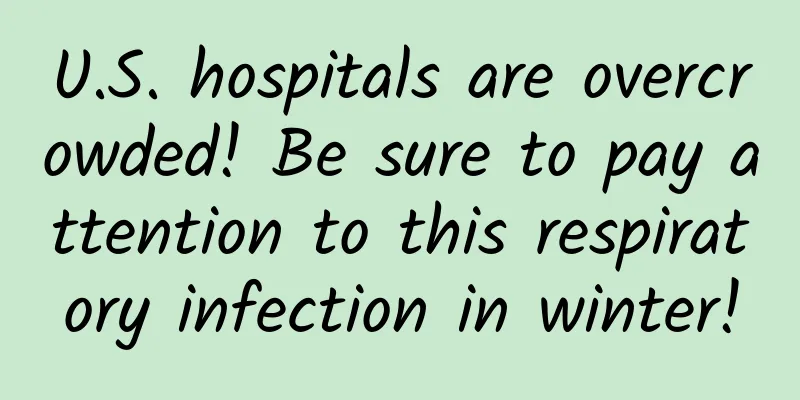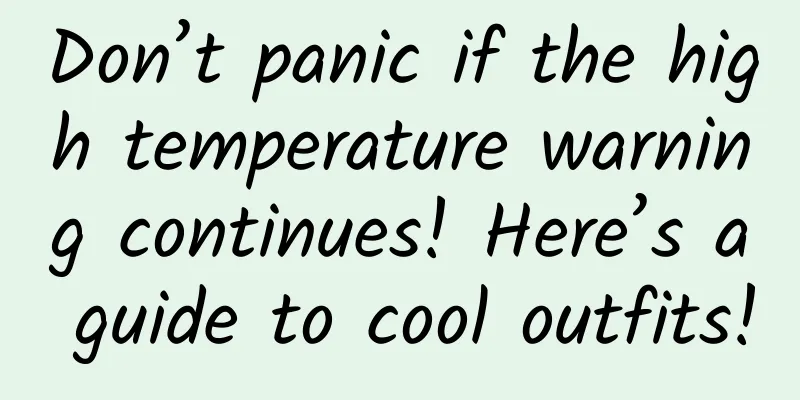U.S. hospitals are overcrowded! Be sure to pay attention to this respiratory infection in winter!

|
Just after the beginning of winter, the chill in Guangzhou is still lingering, and winter has basically arrived in all parts of the country. In this situation, many parents have already taken precautions. According to past experience, the next period is the time when various respiratory viruses are rampant, and children may be infected and catch a cold or even the flu if they are not careful. But this news seemed to have come from the other side of the ocean first. In the past few weeks, emergency rooms and intensive care units in children's hospitals across the United States have been overwhelmed by large-scale viral infections. They have recently been plagued by multiple viruses, mainly RSV, in addition to influenza virus, rhinovirus, enterovirus and new coronavirus. RSV stands for respiratory syncytial virus. The CDC in the United States has monitored an increase in RSV testing and RSV-related emergency department visits and hospitalizations in several regions, with some regions approaching seasonal peak levels. A local doctor said that in this epidemic, the number of infants and young children infected with RSV in hospitals and critically ill patients seemed to have increased significantly compared with previous years. To prevent you from worrying too much, let me first tell you that RSV is not a new virus, but an "old" respiratory virus that pediatricians are very familiar with. Almost all children have been infected with RSV during infancy (mostly before the age of 2). Since they cannot form permanent immunity, they may be infected multiple times afterwards. It is the most common cause of pneumonia and bronchiolitis in infants. Copyright image, no permission to reprint If the improvement of a child's immune system is described as a process of fighting monsters and leveling up, then RSV is more like a mid-level boss that has been wandering around the novice village and the wild, specifically bullying the weak and taking advantage of opportunities from time to time. Most pediatricians are basically familiar with RSV, but RSV has been making its presence felt in the past two years, which is really worrying. The main season for RSV transmission in the northern hemisphere is winter. The outbreak in the United States is considered to be premature. Some experts speculate that this may be related to the reduction in the prevalence of various viruses since the COVID-19 epidemic, the reduction in early childhood exposure, and the lack of physical exercise and insufficient accumulation of protective power. The RSV epidemic trend in the UK in the past two years has also been different from usual. According to a study published in The Lancet Infectious Diseases in September this year: In the winter of late 2020 and early 2021, the number of RSV laboratory-confirmed cases in the UK dropped sharply, 10,280 cases less than expected when COVID-19 prevention measures did not affect RSV activity. Then there was an unprecedented surge in the summer of 2021, with an additional 11,255 laboratory-confirmed cases over the predicted value and a 10.7% increase in the number of hospitalizations. The researchers explained that this phenomenon may be related to the relaxation of government epidemic prevention restrictions. According to statistics, the winter epidemic data from the end of 2021 to the beginning of 2022 was also lower than expected. The research data only goes up to March 2022, and in fact, the UK seems to be "repeating the same mistakes" this summer. The improvement of children’s immune system is a long process. Whether it is RSV, influenza virus, rhinovirus or other common respiratory viruses, children will always encounter and “fight” with them. However, we cannot relax because of this, especially RSV, which is quite aggressive to infants and young children. When children may not be able to resist, it is necessary for parents to take preventive measures and prepare response plans in advance. RSV is a major cause of mortality in infants and young children. Globally, it is estimated that up to 2.3% of neonatal deaths in 0-27 days of age are caused by RSV, 6.7% in infants 28-364 days of age, and 1.6% in children 1-4 years of age. Among infants 28-364 days of age, RSV infection is estimated to cause more deaths than any other single pathogen infection (except malaria). The peak season for winter colds is coming soon. Since RSV is actually very common but many parents are not familiar with it, today I will mainly talk about RSV and share some basic prevention and care knowledge. Friends in need can save it. 01 What is respiratory syncytial virus? Respiratory syncytial virus, English name Respiratory Syncytial Virus, referred to as RSV. Most parents have never heard of its name, so when I explain the disease to parents, I say "respiratory syncytial virus infection", and parents often remember "purse virus", and then when they turn around and tell others, they change it to "wallet virus", "very rich virus, how can a virus have money", and some even tell me "rich man virus"... Let me introduce it seriously. RSV was first isolated from chimpanzees with cold symptoms in the 1950s. Later, scientists found this virus in the nasopharyngeal secretions of humans with respiratory diseases. During tissue culture, it was observed that this virus can cause adjacent cells to fuse and form a syncytium-like structure, so it was officially named "respiratory syncytial virus". Electron micrograph showing the morphological features of RSV. Image source: CDC/Palmer EL About the popular season: RSV can cause seasonal outbreaks around the world, with outbreaks in the northern hemisphere generally occurring from October to November to April to May of the following year, with a peak in January or February. In general, fall and winter are the most common seasons. But this rule is not absolute. In tropical and subtropical climates, such as southern my country, seasonal outbreaks of RSV infection are usually associated with the rainy season, and RSV activity may last up to eight months a year. In addition, affected by the epidemic prevention and control policies in the past two years, the occurrence of RSV infection in winter was first significantly reduced, and then non-seasonal activities occurred in spring and early summer as the prevention and control measures were relaxed. About the affected population and symptoms: People of any age may develop acute respiratory disease due to RSV infection, including the strong and healthy adults in front of the screen. However, the symptoms of RSV infection in adults and older healthy children are usually mild, mainly nasal congestion, runny nose, dry cough, low fever, sore throat, sneezing, headache, etc., similar to the common cold, and usually they will recover after resting for one to two weeks. But infants under 12 months of age (especially premature babies), older adults, people with heart or lung disease, and anyone with a weakened immune system (immunocompromised) are at higher risk for severe infection. Severe RSV infection may spread to the lower respiratory tract, causing pneumonia or bronchiolitis, leading to fever, severe cough, wheezing, shortness of breath or difficulty breathing, hypoxia, cyanosis and other uncomfortable symptoms. Infants are the most severely affected group by RSV. Therefore, the signs and symptoms of severe RSV infection in infants are of particular concern: cough; Loss of appetite Feeling tired, sleepy, or hyper more easily than usual; Short, shallow, rapid breathing; The chest muscles and skin pull inward with each breath (indicating difficulty breathing); In a few severe cases, acute respiratory failure and severe sleep apnea may occur. Regarding complications and sequelae: Complications of RSV infection include lung inflammation, middle ear infection, asthma, etc., and hospitalization and infusion are required if necessary. RSV infection is usually self-limited and does not result in significant long-term pulmonary sequelae. However, there is some evidence that RSV infection may be associated with persistent lung function decline and chronic obstructive pulmonary disease in adulthood. In some patients, RSV infection in infancy may be associated with recurrent wheezing. According to the Mayo Clinic, whether adults or children, having RSV may reduce immunity and increase the risk of infection with COVID-19. If infected with RSV and COVID-19 at the same time, the child's condition may be aggravated. Similarly, if a child is infected with RSV and at the same time is infected with other pathogens, such as influenza virus and pneumococcus, the condition may be more complicated and the child may feel more uncomfortable. After understanding these, parents should know that RSV prevention also needs to be taken seriously. So, how to do it specifically? 02 Is there a vaccine available? How to do daily prevention? When it comes to prevention, the first thing many parents think of is: vaccination! Unfortunately, there is no vaccine available for RSV in humans. Since the virus was isolated and identified, relevant vaccine research and development has been ongoing, but there is still no vaccine that has passed review. There is a protective drug (palivizumab) available, but it is currently only used for high-risk children under 2 years old who are at risk of serious complications from RSV, such as premature babies, children with chronic lung disease, certain heart defects, and weakened immune systems. In addition, the drug is expensive and requires monthly injections, which is a big burden to use. In this case, it is particularly important to master the measures to prevent RSV, including: 1. Wash your hands frequently. RSV can be transmitted through direct contact (such as handshakes). Whether at home or outdoors, you should wash your hands frequently. If someone in your home has symptoms of fever or cold, you should be more vigilant. 2. Keep it clean. RSV can survive for hours on hard objects such as crib rails and toys. Keep kitchen and bathroom countertops and door handles clean, and clean your child's toys regularly. 3. Don't smoke. Babies exposed to tobacco smoke are at higher risk of RSV and may develop severe symptoms. If you can't quit smoking for a while, at least don't smoke at home or in the car. 4. Pay attention to cough hygiene. RSV can be transmitted through droplets in the air, and the eyes, mouth and nose are important portals for it to invade the human body. When family members cough or sneeze, they should cover their mouths and noses with sleeves/elbows/tissues, and then wash their hands in time. 5. Avoid going to crowded places. Infected people are usually most contagious in the first week after infection, but in infants (including those with weaker immunity), the virus may continue to spread for up to 4 weeks even after symptoms disappear. Copyright image, no permission to reprint During RSV epidemic season or in epidemic areas, try not to bring high-risk infants (such as the children with weakened immune function mentioned above) to crowded places such as nurseries. In fact, the prevention methods for RSV and other viruses that cause respiratory diseases are similar. Parents who have experienced their children's colds, flu, and pneumonia several times, I believe they can understand this. 03 What should I do if my child is infected? What should you do if your child is accidentally infected? Actually, there is no need to panic. As mentioned earlier, RSV has been around for more than 60 years and is common enough in our lives. We pediatricians also know enough about it to know how to better diagnose and treat a child infected with RSV. Generally speaking, doctors will make a comprehensive judgment on whether a child is infected with RSV based on the child's symptoms and signs, as well as the time of year when the disease occurs. Additional testing is not necessary. However, sometimes doctors will need to do some tests to assist in diagnosing the child's condition or to rule out other diseases with similar symptoms. For example, to determine whether the child is suffering from hypoxia, an oxygen saturation test may be required; to rule out infection with other pathogens, a nasopharyngeal swab test may be required. In terms of treatment, more supportive treatment is given, that is, to make the child as comfortable as possible during the natural recovery process. For example, if a child is very uncomfortable due to fever, you can use acetaminophen or ibuprofen to reduce the temperature; if the child has dry mouth and tongue, you can provide plenty of fluids to relieve the symptoms and prevent dehydration; if the child has a stuffy nose and cannot sleep at night, you can use saline nasal drops to soften and clear nasal secretions, and turn on a humidifier to moisten the air. We generally do not recommend routine use of bronchodilators, glucocorticoids, and ribavirin for children with RSV bronchiolitis unless the patient has special circumstances, such as impaired immune function, in which case they should be used based on actual needs. 04 Doctor Mom said at the end Seeing this, I believe many parents have realized that respiratory syncytial virus, like pathogens such as influenza virus, adenovirus, and pneumococcus, has long been integrated into our lives. Many parents have unknowingly fought it several times, helping their children defeat the virus time and time again. As children grow older, their immune systems gradually improve and they are no longer afraid of this former boss. Of course, this process is bound to be accompanied by various uneasiness and anxiety for parents. Although we can avoid misunderstandings by understanding the relevant knowledge of the disease, it is difficult to restrain the instinctive reaction of being a parent. Every time this happens, I want to hug the parents through the screen and say: Don’t be afraid, it will be fine, we are all here. Review|Jie Zhijun Chief Physician of Respiratory Department, Shanghai Fifth People's Hospital, Fudan University Source: Dr. Oxy The cover image and the images in this article are from the copyright library Reproduction of image content is not authorized |
>>: After living on land for a long time, can you return to the ocean to live a "carefree" life?
Recommend
Public account operation: How to attract the audience’s scarce attention amidst an overabundance of content?
Official accounts are the only traffic pool in th...
Ten years! China's first tropical ocean ranch in Sanya, Hainan has achieved remarkable results
"We basically stay underwater all year round...
What are the functions of Foshan flower group buying mini program? How much does it cost to develop a flower shop mini program?
Every time a festival comes, many people will buy...
How to get started with user operations in 4 steps?
I believe that those who are engaged in operation...
To do a good job of through train promotion, we need to simplify the cumbersome
Almost all real sellers have used Through Train. ...
This year's Lantern Festival coincides with a super small moon! Why does the moon change in size?
This year's Lantern Festival happened to be t...
If you pinch a tiger by the scruff of its neck, will it become as obedient as a cat?
Can you control the tiger? Written by Su Chengyu ...
The heaviest bird's nest in the world is 1 meter high, 4 meters in diameter and weighs 4 tons.
Although birds yearn for the sky, they also need ...
Who is the force in the universe that can "tear apart" stars?
Astronomers witnessed 18 voracious black holes te...
Are TV games revisiting classics game remakes or just rehashing old stuff?
Remaking classic games from the past and releasin...
The new gameplay of video websites from the popularity of "The Return"
A video website opened an "eco-store" o...
A complete analysis of Pinduoduo’s operating model and methods
Let’s talk about Pinduoduo today. New Market In t...
Analyze 11 reasons why your Mac may become laggy
Although Mac OS is better at system optimization ...
Hyundai builds hydrogen fuel cell car with a range of up to 800 kilometers. New energy vehicles will usher in new opportunities
Today, the automobile industry has gradually retu...
Qualities of a Project Leader
Many projects have several types of Leaders: 1. G...









